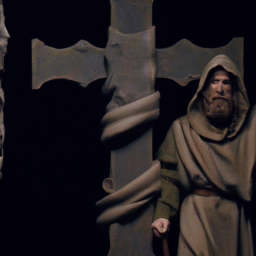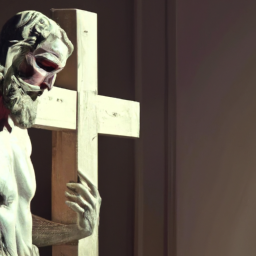Unveiling the Enigma: Discovering the Truth Behind Jesus’ Crucifixion
Introduction
Unveiling the Enigma: Pontius Pilate, the Roman Governor Behind Jesus’ Crucifixion is a historical exploration that delves into the life and role of Pontius Pilate, the Roman governor who played a pivotal role in the crucifixion of Jesus Christ. This book aims to shed light on the enigmatic figure of Pilate, examining his background, political motivations, and the circumstances that led to his fateful decision. Through meticulous research and analysis of historical sources, the author seeks to provide a comprehensive understanding of Pilate’s actions and their profound impact on one of the most significant events in human history.
The Historical Role of Pontius Pilate in Jesus’ Crucifixion
Unveiling the Enigma: Pontius Pilate, the Roman Governor Behind Jesus’ Crucifixion
The historical role of Pontius Pilate in Jesus’ crucifixion is a topic that has fascinated scholars and theologians for centuries. As the Roman governor of Judea during the first century AD, Pilate played a pivotal role in the events leading up to the crucifixion of Jesus Christ. Understanding his actions and motivations is crucial to comprehending the complex dynamics of this pivotal moment in history.
To fully grasp Pilate’s role, it is essential to delve into the political and religious context of the time. Judea was a volatile region under Roman rule, with a diverse population that included Jews, Samaritans, and other ethnic groups. The Jewish religious leaders held significant influence over the local population, and tensions between them and the Roman authorities were often high.
Pilate’s primary responsibility was to maintain order and ensure Roman control over the region. He had a reputation for being a tough and uncompromising governor, known for his brutal suppression of any form of dissent. However, he also had to navigate the delicate balance of appeasing the Jewish religious leaders while upholding Roman law.
It was against this backdrop that Jesus, a charismatic preacher and healer, emerged as a figure of controversy. His teachings challenged the authority of both the Jewish religious leaders and the Roman occupiers. As his popularity grew, so did the concerns of the Jewish religious elite, who saw him as a threat to their power and influence.
The Jewish religious leaders, led by the high priest Caiaphas, sought to eliminate Jesus. However, they lacked the authority to carry out a death sentence under Roman law. This is where Pilate’s role becomes crucial. The religious leaders brought Jesus before Pilate, accusing him of sedition and claiming that he posed a threat to Roman rule.
Pilate, aware of the delicate political situation, initially tried to avoid getting involved. He questioned Jesus, hoping to find a reason to release him. However, the religious leaders were relentless in their accusations, and the crowd that had gathered outside the governor’s residence demanded Jesus’ crucifixion.
Feeling the pressure, Pilate attempted to appease the crowd by offering to release Jesus or another prisoner, as was the custom during the Jewish festival of Passover. However, the religious leaders incited the crowd to demand the release of Barabbas, a notorious criminal, instead of Jesus.
Realizing that his attempts at compromise were failing, Pilate reluctantly gave in to the demands of the crowd. He ordered Jesus to be crucified, washing his hands in a symbolic gesture to absolve himself of responsibility. This act has become synonymous with Pilate’s role in Jesus’ crucifixion, forever immortalized in the biblical narrative.
The historical role of Pontius Pilate in Jesus’ crucifixion is a complex and multifaceted one. While he may have been driven by political expediency and a desire to maintain order, his actions ultimately led to the death of an innocent man. Understanding the historical context and the pressures Pilate faced helps shed light on the choices he made and the consequences they had.
In conclusion, Pontius Pilate’s role in Jesus’ crucifixion cannot be understated. As the Roman governor of Judea, he found himself caught between the demands of the Jewish religious leaders and the need to maintain Roman control. His actions, driven by political expediency and a desire to appease the crowd, ultimately led to the crucifixion of Jesus Christ. Unraveling the enigma of Pontius Pilate is essential to understanding the historical significance of this pivotal moment in human history.
Unraveling the Personality of Pontius Pilate: Insights from Historical Accounts

Unveiling the Enigma: Pontius Pilate, the Roman Governor Behind Jesus’ Crucifixion
Unraveling the Personality of Pontius Pilate: Insights from Historical Accounts
Pontius Pilate, the Roman governor who presided over the trial and crucifixion of Jesus Christ, remains an enigmatic figure in history. While his role in one of the most significant events in Christianity is well-documented, understanding his personality and motivations requires a closer examination of historical accounts.
Historians have pieced together a portrait of Pilate through various sources, including the New Testament, Roman records, and writings from contemporary historians. These accounts provide valuable insights into the man behind the infamous decision to crucify Jesus.
One aspect that emerges from historical accounts is Pilate’s complex relationship with the Jewish population under his rule. As governor of Judea, he faced the challenging task of maintaining Roman control while navigating the delicate religious and political landscape of the region. Pilate’s interactions with the Jewish leaders reveal a mix of pragmatism, political maneuvering, and occasional brutality.
One notable incident that sheds light on Pilate’s character is his clash with the Jewish religious leaders over the use of funds from the Temple treasury. According to the Gospel of Luke, Pilate used money from the treasury to finance the construction of an aqueduct, a move that outraged the Jewish population. In response, Pilate ordered his soldiers to infiltrate a crowd of protesters and brutally suppress the demonstration. This incident highlights Pilate’s willingness to use force to maintain order and protect Roman interests.
Another aspect of Pilate’s personality that emerges from historical accounts is his tendency to vacillate in decision-making. The Gospel accounts depict him as torn between his desire to appease the Jewish leaders and his reluctance to condemn an innocent man. Pilate’s wavering is evident in his repeated attempts to release Jesus, despite pressure from the crowd and the Jewish leaders. However, his fear of a potential uprising and his desire to maintain his position ultimately led him to give in to the demands for crucifixion.
Pilate’s reputation for cruelty is also evident in historical accounts. Roman records describe him as a governor who ruled with an iron fist, often resorting to violence to quell dissent. His brutal suppression of the aforementioned protest over the use of Temple funds is just one example of his heavy-handed approach. Additionally, the Gospel accounts mention Pilate’s willingness to order the crucifixion of Jesus, a punishment reserved for the most heinous crimes. This suggests a man who was not hesitant to use extreme measures to maintain control.
Despite his flaws, Pilate’s actions during Jesus’ trial and crucifixion were not without moments of moral conflict. The Gospel of Matthew recounts Pilate’s wife’s dream, warning him of the innocence of Jesus. This dream, coupled with Pilate’s repeated attempts to release Jesus, suggests a man grappling with his conscience. However, his fear of political repercussions and his desire to maintain Roman authority ultimately overpowered any moral qualms he may have had.
In conclusion, historical accounts provide valuable insights into the personality of Pontius Pilate, the Roman governor behind Jesus’ crucifixion. His complex relationship with the Jewish population, his tendency to vacillate in decision-making, and his reputation for cruelty all contribute to a multifaceted portrait of a man caught between political expediency and moral conflict. Understanding Pilate’s motivations and actions allows us to delve deeper into the historical context surrounding Jesus’ crucifixion and the impact it had on both Christianity and Roman rule in Judea.
Pontius Pilate’s Legacy: Impact on Early Christianity and Beyond
Pontius Pilate, the Roman governor who presided over the trial and crucifixion of Jesus Christ, left a lasting legacy that continues to shape the course of history. His role in the crucifixion has been a subject of much debate and speculation, but there is no denying the impact he had on early Christianity and beyond.
Pilate’s actions during Jesus’ trial have been the subject of intense scrutiny. Some argue that he was merely a pawn in a larger political game, while others believe he had the power to save Jesus but chose not to. Regardless of his motivations, Pilate’s decision to condemn Jesus to death had far-reaching consequences.
One of the most significant impacts of Pilate’s actions was the martyrdom of Jesus. His crucifixion became a central event in Christian theology, symbolizing sacrifice and redemption. The early Christians saw Jesus’ death as a necessary step in God’s plan for salvation, and Pilate’s role in this event became a crucial part of their narrative.
Furthermore, Pilate’s decision to crucify Jesus solidified his status as a figure of controversy and condemnation. In the eyes of many Christians, he became the embodiment of evil, forever associated with the betrayal and execution of their savior. This perception of Pilate as a villain has persisted throughout history, shaping the way he is remembered and portrayed in religious texts and artistic depictions.
Pilate’s legacy also extends beyond the realm of Christianity. His actions during Jesus’ trial had political implications that reverberated throughout the Roman Empire. The Jewish leaders who brought Jesus before Pilate accused him of claiming to be the King of the Jews, a charge that could be seen as a challenge to Roman authority. By condemning Jesus to death, Pilate sent a clear message to the Jewish population that Rome would not tolerate any threats to its power.
This message had a profound impact on the relationship between Rome and its Jewish subjects. It further strained an already tense situation, leading to increased tensions and eventually the Jewish revolt against Roman rule. Pilate’s decision to crucify Jesus can be seen as a catalyst for these events, setting in motion a chain of events that would ultimately lead to the destruction of the Second Temple and the dispersal of the Jewish people.
In addition to his role in shaping the course of history, Pilate’s legacy also raises important questions about the nature of power and responsibility. Was Pilate merely a pawn in a larger political game, or did he have the power to save Jesus? Should he be held accountable for his actions, or was he simply following orders? These questions continue to be debated by scholars and theologians, highlighting the complex and often ambiguous nature of historical events.
In conclusion, Pontius Pilate’s role in Jesus’ crucifixion left a lasting legacy that continues to shape the course of history. His actions had a profound impact on early Christianity, solidifying Jesus’ martyrdom and shaping the way he is remembered. Pilate’s decision also had political implications, contributing to the strained relationship between Rome and its Jewish subjects. Furthermore, his legacy raises important questions about power and responsibility that continue to be debated today. The enigma of Pontius Pilate remains, a figure whose actions continue to captivate and intrigue scholars and believers alike.
Q&A
1. Who is the author of “Unveiling the Enigma: Pontius Pilate, the Roman Governor Behind Jesus’ Crucifixion”?
David K. Breed
2. What is the main focus of “Unveiling the Enigma: Pontius Pilate, the Roman Governor Behind Jesus’ Crucifixion”?
The book explores the historical background and role of Pontius Pilate in the crucifixion of Jesus.
3. Is “Unveiling the Enigma: Pontius Pilate, the Roman Governor Behind Jesus’ Crucifixion” a work of fiction or non-fiction?
Non-fiction.
Conclusion
In conclusion, “Unveiling the Enigma: Pontius Pilate, the Roman Governor Behind Jesus’ Crucifixion” sheds light on the historical figure of Pontius Pilate and his role in the crucifixion of Jesus. The book provides a comprehensive analysis of Pilate’s background, his interactions with Jesus, and the political and religious dynamics of the time. Through meticulous research and examination of ancient texts, the author presents a compelling narrative that deepens our understanding of this pivotal event in history. Overall, “Unveiling the Enigma” offers valuable insights into the complex character of Pontius Pilate and his involvement in Jesus’ crucifixion.


